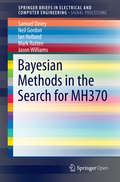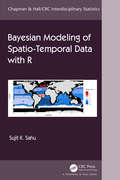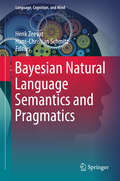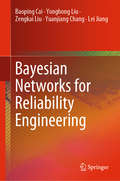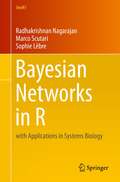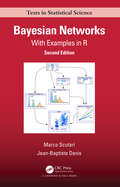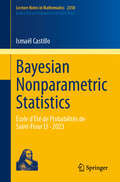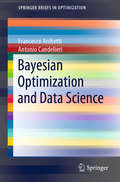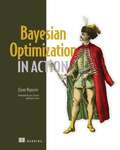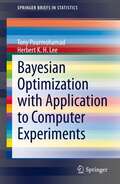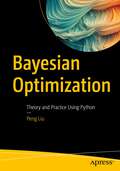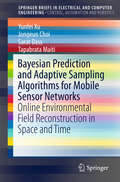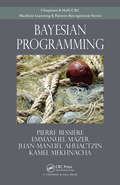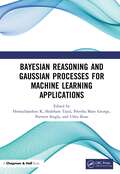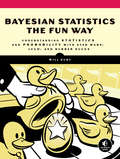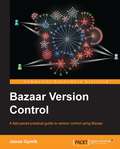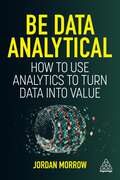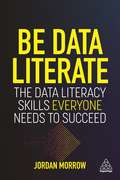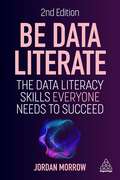- Table View
- List View
Bayesian Methods in the Search for MH370 (SpringerBriefs in Electrical and Computer Engineering)
by Neil Gordon Jason Williams Sam Davey Ian Holland Mark RuttenThis book demonstrates how nonlinear/non-Gaussian Bayesian time series estimation methods were used to produce a probability distribution of potential MH370 flight paths. It provides details of how the probabilistic models of aircraft flight dynamics, satellite communication system measurements, environmental effects and radar data were constructed and calibrated. The probability distribution was used to define the search zone in the southern Indian Ocean.The book describes particle-filter based numerical calculation of the aircraft flight-path probability distribution and validates the method using data from several of the involved aircraft’s previous flights. Finally it is shown how the Reunion Island flaperon debris find affects the search probability distribution.
Bayesian Modeling and Computation in Python (Chapman & Hall/CRC Texts in Statistical Science)
by Osvaldo A. Martin Ravin Kumar Junpeng LaoBayesian Modeling and Computation in Python aims to help beginner Bayesian practitioners to become intermediate modelers. It uses a hands on approach with PyMC3, Tensorflow Probability, ArviZ and other libraries focusing on the practice of applied statistics with references to the underlying mathematical theory. The book starts with a refresher of the Bayesian Inference concepts. The second chapter introduces modern methods for Exploratory Analysis of Bayesian Models. With an understanding of these two fundamentals the subsequent chapters talk through various models including linear regressions, splines, time series, Bayesian additive regression trees. The final chapters include Approximate Bayesian Computation, end to end case studies showing how to apply Bayesian modelling in different settings, and a chapter about the internals of probabilistic programming languages. Finally the last chapter serves as a reference for the rest of the book by getting closer into mathematical aspects or by extending the discussion of certain topics. This book is written by contributors of PyMC3, ArviZ, Bambi, and Tensorflow Probability among other libraries.
Bayesian Modeling of Spatio-Temporal Data with R (Chapman & Hall/CRC Interdisciplinary Statistics)
by Sujit SahuApplied sciences, both physical and social, such as atmospheric, biological, climate, demographic, economic, ecological, environmental, oceanic and political, routinely gather large volumes of spatial and spatio-temporal data in order to make wide ranging inference and prediction. Ideally such inferential tasks should be approached through modelling, which aids in estimation of uncertainties in all conclusions drawn from such data. Unified Bayesian modelling, implemented through user friendly software packages, provides a crucial key to unlocking the full power of these methods for solving challenging practical problems. Key features of the book: • Accessible detailed discussion of a majority of all aspects of Bayesian methods and computations with worked examples, numerical illustrations and exercises • A spatial statistics jargon buster chapter that enables the reader to build up a vocabulary without getting clouded in modeling and technicalities • Computation and modeling illustrations are provided with the help of the dedicated R package bmstdr, allowing the reader to use well-known packages and platforms, such as rstan, INLA, spBayes, spTimer, spTDyn, CARBayes, CARBayesST, etc • Included are R code notes detailing the algorithms used to produce all the tables and figures, with data and code available via an online supplement • Two dedicated chapters discuss practical examples of spatio-temporal modeling of point referenced and areal unit data • Throughout, the emphasis has been on validating models by splitting data into test and training sets following on the philosophy of machine learning and data science This book is designed to make spatio-temporal modeling and analysis accessible and understandable to a wide audience of students and researchers, from mathematicians and statisticians to practitioners in the applied sciences. It presents most of the modeling with the help of R commands written in a purposefully developed R package to facilitate spatio-temporal modeling. It does not compromise on rigour, as it presents the underlying theories of Bayesian inference and computation in standalone chapters, which would be appeal those interested in the theoretical details. By avoiding hard core mathematics and calculus, this book aims to be a bridge that removes the statistical knowledge gap from among the applied scientists.
Bayesian Natural Language Semantics and Pragmatics (Language, Cognition, and Mind #2)
by Henk Zeevat Hans-Christian SchmitzThe contributions in this volume focus on the Bayesian interpretation of natural languages, which is widely used in areas of artificial intelligence, cognitive science, and computational linguistics. This is the first volume to take up topics in Bayesian Natural Language Interpretation and make proposals based on information theory, probability theory, and related fields. The methodologies offered here extend to the target semantic and pragmatic analyses of computational natural language interpretation. Bayesian approaches to natural language semantics and pragmatics are based on methods from signal processing and the causal Bayesian models pioneered by especially Pearl. In signal processing, the Bayesian method finds the most probable interpretation by finding the one that maximizes the product of the prior probability and the likelihood of the interpretation. It thus stresses the importance of a production model for interpretation as in Grice's contributions to pragmatics or in interpretation by abduction.
Bayesian Networks and Influence Diagrams: A Guide To Construction And Analysis (Information Science and Statistics #22)
by Uffe B. Kjærulff Anders L. MadsenBayesian Networks and Influence Diagrams: A Guide to Construction and Analysis, Second Edition, provides a comprehensive guide for practitioners who wish to understand, construct, and analyze intelligent systems for decision support based on probabilistic networks. This new edition contains six new sections, in addition to fully-updated examples, tables, figures, and a revised appendix. Intended primarily for practitioners, this book does not require sophisticated mathematical skills or deep understanding of the underlying theory and methods nor does it discuss alternative technologies for reasoning under uncertainty. The theory and methods presented are illustrated through more than 140 examples, and exercises are included for the reader to check his or her level of understanding. The techniques and methods presented for knowledge elicitation, model construction and verification, modeling techniques and tricks, learning models from data, and analyses of models have all been developed and refined on the basis of numerous courses that the authors have held for practitioners worldwide.
Bayesian Networks for Reliability Engineering
by Lei Jiang Baoping Cai Yonghong Liu Zengkai Liu Yuanjiang ChangThis book presents a bibliographical review of the use of Bayesian networks in reliability over the last decade. Bayesian network (BN) is considered to be one of the most powerful models in probabilistic knowledge representation and inference, and it is increasingly used in the field of reliability. After focusing on the engineering systems, the book subsequently discusses twelve important issues in the BN-based reliability methodologies, such as BN structure modeling, BN parameter modeling, BN inference, validation, and verification. As such, it is a valuable resource for researchers and practitioners in the field of reliability engineering.
Bayesian Networks in R: with Applications in Systems Biology (Use R! #48)
by Marco Scutari Radhakrishnan Nagarajan Sophie LèbreBayesian Networks in R with Applications in Systems Biology is unique as it introduces the reader to the essential concepts in Bayesian network modeling and inference in conjunction with examples in the open-source statistical environment R. The level of sophistication is also gradually increased across the chapters with exercises and solutions for enhanced understanding for hands-on experimentation of the theory and concepts. The application focuses on systems biology with emphasis on modeling pathways and signaling mechanisms from high-throughput molecular data. Bayesian networks have proven to be especially useful abstractions in this regard. Their usefulness is especially exemplified by their ability to discover new associations in addition to validating known ones across the molecules of interest. It is also expected that the prevalence of publicly available high-throughput biological data sets may encourage the audience to explore investigating novel paradigms using the approaches presented in the book.
Bayesian Networks: With Examples in R (Chapman & Hall/CRC Texts in Statistical Science #109)
by Marco Scutari Jean-Baptiste DenisBayesian Networks: With Examples in R, Second Edition introduces Bayesian networks using a hands-on approach. Simple yet meaningful examples illustrate each step of the modelling process and discuss side-by-side the underlying theory and its application using R code. The examples start from the simplest notions and gradually increase in complexity. In particular, this new edition contains significant new material on topics from modern machine learning practice: dynamic networks, networks with heterogeneous variables, and model validation. The first three chapters explain the whole process of Bayesian network modelling, from structure learning to parameter learning to inference. These chapters cover discrete, Gaussian, and conditional Gaussian Bayesian networks. The following two chapters delve into dynamic networks (to model temporal data) and into networks including arbitrary random variables (using Stan). The book then gives a concise but rigorous treatment of the fundamentals of Bayesian networks and offers an introduction to causal Bayesian networks. It also presents an overview of R packages and other software implementing Bayesian networks. The final chapter evaluates two real-world examples: a landmark causal protein-signaling network published in Science and a probabilistic graphical model for predicting the composition of different body parts. Covering theoretical and practical aspects of Bayesian networks, this book provides you with an introductory overview of the field. It gives you a clear, practical understanding of the key points behind this modelling approach and, at the same time, it makes you familiar with the most relevant packages used to implement real-world analyses in R. The examples covered in the book span several application fields, data-driven models and expert systems, probabilistic and causal perspectives, thus giving you a starting point to work in a variety of scenarios. Online supplementary materials include the data sets and the code used in the book, which will all be made available from https://www.bnlearn.com/book-crc-2ed/
Bayesian Nonparametric Statistics: École d’Été de Probabilités de Saint-Flour LI - 2023 (Lecture Notes in Mathematics #2358)
by Ismaël CastilloThis up-to-date overview of Bayesian nonparametric statistics provides both an introduction to the field and coverage of recent research topics, including deep neural networks, high-dimensional models and multiple testing, Bernstein-von Mises theorems and variational Bayes approximations, many of which have previously only been accessible through research articles. Although Bayesian posterior distributions are widely applied in astrophysics, inverse problems, genomics, machine learning and elsewhere, their theory is still only partially understood, especially in complex settings such as nonparametric or semiparametric models. Here, the available theory on the frequentist analysis of posterior distributions is outlined in terms of convergence rates, limiting shape results and uncertainty quantification. Based on lecture notes for a course given at the St-Flour summer school in 2023, the book is aimed at researchers and graduate students in statistics and probability.
Bayesian Optimization and Data Science (SpringerBriefs in Optimization)
by Francesco Archetti Antonio CandelieriThis volume brings together the main results in the field of Bayesian Optimization (BO), focusing on the last ten years and showing how, on the basic framework, new methods have been specialized to solve emerging problems from machine learning, artificial intelligence, and system optimization. It also analyzes the software resources available for BO and a few selected application areas. Some areas for which new results are shown include constrained optimization, safe optimization, and applied mathematics, specifically BO's use in solving difficult nonlinear mixed integer problems. The book will help bring readers to a full understanding of the basic Bayesian Optimization framework and gain an appreciation of its potential for emerging application areas. It will be of particular interest to the data science, computer science, optimization, and engineering communities.
Bayesian Optimization in Action (In Action)
by Quan NguyenBayesian optimization helps pinpoint the best configuration for your machine learning models with speed and accuracy. Put its advanced techniques into practice with this hands-on guide.In Bayesian Optimization in Action you will learn how to: Train Gaussian processes on both sparse and large data sets Combine Gaussian processes with deep neural networks to make them flexible and expressive Find the most successful strategies for hyperparameter tuning Navigate a search space and identify high-performing regions Apply Bayesian optimization to cost-constrained, multi-objective, and preference optimization Implement Bayesian optimization with PyTorch, GPyTorch, and BoTorch Bayesian Optimization in Action shows you how to optimize hyperparameter tuning, A/B testing, and other aspects of the machine learning process by applying cutting-edge Bayesian techniques. Using clear language, illustrations, and concrete examples, this book proves that Bayesian optimization doesn&’t have to be difficult! You&’ll get in-depth insights into how Bayesian optimization works and learn how to implement it with cutting-edge Python libraries. The book&’s easy-to-reuse code samples let you hit the ground running by plugging them straight into your own projects. Forewords by Luis Serrano and David Sweet. About the technology In machine learning, optimization is about achieving the best predictions—shortest delivery routes, perfect price points, most accurate recommendations—in the fewest number of steps. Bayesian optimization uses the mathematics of probability to fine-tune ML functions, algorithms, and hyperparameters efficiently when traditional methods are too slow or expensive. About the book Bayesian Optimization in Action teaches you how to create efficient machine learning processes using a Bayesian approach. In it, you&’ll explore practical techniques for training large datasets, hyperparameter tuning, and navigating complex search spaces. This interesting book includes engaging illustrations and fun examples like perfecting coffee sweetness, predicting weather, and even debunking psychic claims. You&’ll learn how to navigate multi-objective scenarios, account for decision costs, and tackle pairwise comparisons. What's inside Gaussian processes for sparse and large datasets Strategies for hyperparameter tuning Identify high-performing regions Examples in PyTorch, GPyTorch, and BoTorch About the reader For machine learning practitioners who are confident in math and statistics. About the author Quan Nguyen is a research assistant at Washington University in St. Louis. He writes for the Python Software Foundation and has authored several books on Python programming. Table of Contents 1 Introduction to Bayesian optimization 2 Gaussian processes as distributions over functions 3 Customizing a Gaussian process with the mean and covariance functions 4 Refining the best result with improvement-based policies 5 Exploring the search space with bandit-style policies 6 Leveraging information theory with entropy-based policies 7 Maximizing throughput with batch optimization 8 Satisfying extra constraints with constrained optimization 9 Balancing utility and cost with multifidelity optimization 10 Learning from pairwise comparisons with preference optimization 11 Optimizing multiple objectives at the same time 12 Scaling Gaussian processes to large datasets 13 Combining Gaussian processes with neural networks
Bayesian Optimization with Application to Computer Experiments (SpringerBriefs in Statistics)
by Tony Pourmohamad Herbert K. H. LeeThis book introduces readers to Bayesian optimization, highlighting advances in the field and showcasing its successful applications to computer experiments. R code is available as online supplementary material for most included examples, so that readers can better comprehend and reproduce methods. Compact and accessible, the volume is broken down into four chapters. Chapter 1 introduces the reader to the topic of computer experiments; it includes a variety of examples across many industries. Chapter 2 focuses on the task of surrogate model building and contains a mix of several different surrogate models that are used in the computer modeling and machine learning communities. Chapter 3 introduces the core concepts of Bayesian optimization and discusses unconstrained optimization. Chapter 4 moves on to constrained optimization, and showcases some of the most novel methods found in the field. This will be a useful companion to researchers and practitioners working with computer experiments and computer modeling. Additionally, readers with a background in machine learning but minimal background in computer experiments will find this book an interesting case study of the applicability of Bayesian optimization outside the realm of machine learning.
Bayesian Optimization: Theory and Practice Using Python
by Peng LiuThis book covers the essential theory and implementation of popular Bayesian optimization techniques in an intuitive and well-illustrated manner. The techniques covered in this book will enable you to better tune the hyperparemeters of your machine learning models and learn sample-efficient approaches to global optimization.The book begins by introducing different Bayesian Optimization (BO) techniques, covering both commonly used tools and advanced topics. It follows a “develop from scratch” method using Python, and gradually builds up to more advanced libraries such as BoTorch, an open-source project introduced by Facebook recently. Along the way, you’ll see practical implementations of this important discipline along with thorough coverage and straightforward explanations of essential theories. This book intends to bridge the gap between researchers and practitioners, providing both with a comprehensive, easy-to-digest, and useful reference guide. After completing this book, you will have a firm grasp of Bayesian optimization techniques, which you’ll be able to put into practice in your own machine learning models.What You Will LearnApply Bayesian Optimization to build better machine learning modelsUnderstand and research existing and new Bayesian Optimization techniquesLeverage high-performance libraries such as BoTorch, which offer you the ability to dig into and edit the inner workingDig into the inner workings of common optimization algorithms used to guide the search process in Bayesian optimizationWho This Book Is ForBeginner to intermediate level professionals in machine learning, analytics or other roles relevant in data science.
Bayesian Prediction and Adaptive Sampling Algorithms for Mobile Sensor Networks: Online Environmental Field Reconstruction in Space and Time (SpringerBriefs in Electrical and Computer Engineering)
by Jongeun Choi Yunfei Xu Sarat Dass Tapabrata MaitiThis brief introduces a class of problems and models for the prediction of the scalar field of interest from noisy observations collected by mobile sensor networks. It also introduces the problem of optimal coordination of robotic sensors to maximize the prediction quality subject to communication and mobility constraints either in a centralized or distributed manner. To solve such problems, fully Bayesian approaches are adopted, allowing various sources of uncertainties to be integrated into an inferential framework effectively capturing all aspects of variability involved. The fully Bayesian approach also allows the most appropriate values for additional model parameters to be selected automatically by data, and the optimal inference and prediction for the underlying scalar field to be achieved. In particular, spatio-temporal Gaussian process regression is formulated for robotic sensors to fuse multifactorial effects of observations, measurement noise, and prior distributions for obtaining the predictive distribution of a scalar environmental field of interest. New techniques are introduced to avoid computationally prohibitive Markov chain Monte Carlo methods for resource-constrained mobile sensors. Bayesian Prediction and Adaptive Sampling Algorithms for Mobile Sensor Networks starts with a simple spatio-temporal model and increases the level of model flexibility and uncertainty step by step, simultaneously solving increasingly complicated problems and coping with increasing complexity, until it ends with fully Bayesian approaches that take into account a broad spectrum of uncertainties in observations, model parameters, and constraints in mobile sensor networks. The book is timely, being very useful for many researchers in control, robotics, computer science and statistics trying to tackle a variety of tasks such as environmental monitoring and adaptive sampling, surveillance, exploration, and plume tracking which are of increasing currency. Problems are solved creatively by seamless combination of theories and concepts from Bayesian statistics, mobile sensor networks, optimal experiment design, and distributed computation.
Bayesian Programming (Chapman & Hall/CRC Machine Learning & Pattern Recognition)
by Pierre Bessiere Emmanuel Mazer Juan Ahuactzin Kamel MekhnachaA new modeling methodology, new inference algorithms, new programming languages, and new hardware are all needed to create a complete Bayesian computing framework. Focusing on the methodology and algorithms, this book describes the first steps toward reaching that goal. It emphasizes probability as an alternative to Boolean logic, covering new methods to build probabilistic programs for real-world applications. The book encourages readers to explore emerging areas and develop new programming languages and hardware architectures. A Python package is available on a supplementary website.
Bayesian Reasoning and Gaussian Processes for Machine Learning Applications
by Hemachandran KThis book introduces Bayesian reasoning and Gaussian processes into machine learning applications. Bayesian methods are applied in many areas, such as game development, decision making, and drug discovery. It is very effective for machine learning algorithms in handling missing data and extracting information from small datasets. Bayesian Reasoning and Gaussian Processes for Machine Learning Applications uses a statistical background to understand continuous distributions and how learning can be viewed from a probabilistic framework. The chapters progress into such machine learning topics as belief network and Bayesian reinforcement learning, which is followed by Gaussian process introduction, classification, regression, covariance, and performance analysis of Gaussian processes with other models. FEATURES Contains recent advancements in machine learning Highlights applications of machine learning algorithms Offers both quantitative and qualitative research Includes numerous case studies This book is aimed at graduates, researchers, and professionals in the field of data science and machine learning.
Bayesian Reasoning and Machine Learning
by David BarberMachine learning methods extract value from vast data sets quickly and with modest resources. They are established tools in a wide range of industrial applications, including search engines, DNA sequencing, stock market analysis, and robot locomotion, and their use is spreading rapidly. People who know the methods have their choice of rewarding jobs. This hands-on text opens these opportunities to computer science students with modest mathematical backgrounds. It is designed for final-year undergraduates and master's students with limited background in linear algebra and calculus. Comprehensive and coherent, it develops everything from basic reasoning to advanced techniques within the framework of graphical models. Students learn more than a menu of techniques, they develop analytical and problem-solving skills that equip them for the real world. Numerous examples and exercises, both computer based and theoretical, are included in every chapter. Resources for students and instructors, including a MATLAB toolbox, are available online.
Bayesian Statistics and New Generations: BAYSM 2018, Warwick, UK, July 2-3 Selected Contributions (Springer Proceedings in Mathematics & Statistics #296)
by Raffaele Argiento Daniele Durante Sara WadeThis book presents a selection of peer-reviewed contributions to the fourth Bayesian Young Statisticians Meeting, BAYSM 2018, held at the University of Warwick on 2-3 July 2018. The meeting provided a valuable opportunity for young researchers, MSc students, PhD students, and postdocs interested in Bayesian statistics to connect with the broader Bayesian community. The proceedings offer cutting-edge papers on a wide range of topics in Bayesian statistics, identify important challenges and investigate promising methodological approaches, while also assessing current methods and stimulating applications. The book is intended for a broad audience of statisticians, and demonstrates how theoretical, methodological, and computational aspects are often combined in the Bayesian framework to successfully tackle complex problems.
Bayesian Statistics the Fun Way: Understanding Statistics and Probability with Star Wars, LEGO, and Rubber Ducks
by Will KurtFun guide to learning Bayesian statistics and probability through unusual and illustrative examples.Probability and statistics are increasingly important in a huge range of professions. But many people use data in ways they don't even understand, meaning they aren't getting the most from it. Bayesian Statistics the Fun Way will change that.This book will give you a complete understanding of Bayesian statistics through simple explanations and un-boring examples. Find out the probability of UFOs landing in your garden, how likely Han Solo is to survive a flight through an asteroid shower, how to win an argument about conspiracy theories, and whether a burglary really was a burglary, to name a few examples.By using these off-the-beaten-track examples, the author actually makes learning statistics fun. And you'll learn real skills, like how to:- How to measure your own level of uncertainty in a conclusion or belief- Calculate Bayes theorem and understand what it's useful for- Find the posterior, likelihood, and prior to check the accuracy of your conclusions- Calculate distributions to see the range of your data- Compare hypotheses and draw reliable conclusions from themNext time you find yourself with a sheaf of survey results and no idea what to do with them, turn to Bayesian Statistics the Fun Way to get the most value from your data.
Bazaar Version Control
by Janos GyerikThis book is a step-by-step tutorial for beginner to intermediate developers who want to get started with Bazaar quickly.This book is designed for anyone who may be new to version control systems. If you are a programmer, system administrator, designer, writer, or translator, you can benefit greatly from using Bazaar in your projects. Those who are familiar with version control systems will find this book a fast and easy way to understand Bazaar.
Be Data Analytical: How to Use Analytics to Turn Data into Value
by Jordan MorrowBe Data Analytical is the book organizations and individuals need to understand how to truly use analytics to turn data into valuable insights and drive smarter decision making.Data needs analytics to turn it into value and for organizations to be truly data-driven, they need to use analytics correctly. However, most organizations do not move beyond the first, most rudimentary stage of analytics. They miss out on the powerful insights and opportunities available with all the four levels of analytics: descriptive, diagnostic, predictive and prescriptive. Be Data Analytical reveals how to supercharge data value through all the four levels of analytics, bringing data to life and enhancing data-driven decision making. Be Data Analytical examines each of these four levels of analytics in-depth: what they are, why they matter, how they can be used strategically and how they can be implemented. The book also explores how individuals and organizations can improve their skills and performance in each of these areas. Written by a global trailblazer in the world of data literacy, the book shows professionals, managers, leaders and organizations how to use analytics for the successful and strategic conversion of data into value, insight and action.
Be Data Driven: How Organizations Can Harness the Power of Data
by Jordan MorrowMake any team or business data driven with this practical guide to overcoming common challenges and creating a data culture. Businesses are increasingly focusing on their data and analytics strategy, but a data-driven culture grounded in evidence-based decision making can be difficult to achieve. Be Data Driven outlines a step-by-step roadmap to building a data-driven organization or team, beginning with deciding on outcomes and a strategy before moving onto investing in technology and upskilling where necessary. This practical guide explains what it means to be a data-driven organization and explores which technologies are advancing data and analytics. Crucially, it also examines the most common challenges to becoming data driven, from a foundational skills gap to issues with leadership and strategy and the impact of organizational culture. With case studies of businesses who have successfully used data, Be Data Driven shows managers, leaders and data professionals how to address hurdles, encourage a data culture and become truly data driven.
Be Data Literate: The Data Literacy Skills Everyone Needs To Succeed
by Jordan MorrowIn the fast moving world of the fourth industrial revolution not everyone needs to be a data scientist but everyone should be data literate, with the ability to read, analyze and communicate with data.It is not enough for a business to have the best data if those using it don't understand the right questions to ask or how to use the information generated to make decisions. Be Data Literate is the essential guide to developing the curiosity, creativity and critical thinking necessary to make anyone data literate, without retraining as a data scientist or statistician. With learnings to show development and real-world examples from industries implementing data literacy skills, this book explains how to confidently read and speak the 'language of data' in the modern business environment and everyday life. Be Data Literate is a practical guide to understanding the four levels of analytics, how to analyze data and the key steps to making smarter, data-informed decisions. Written by a founding pioneer and worldwide leading expert on data literacy, this book empowers professionals with the skills they need to succeed in the digital world.
Be Data Literate: The Data Literacy Skills Everyone Needs to Succeed
by Jordan MorrowWINNER: International Book Awards 2023 - Business: Technology (1st edition) Not everyone needs to be a data scientist, but everyone should be data literate in a fast-moving world that brings new technological developments every day. It is not enough for a business to have the best data if those using it don't understand the right questions to ask or how to use the information generated to make decisions. Be Data Literate is the essential guide to developing the curiosity, creativity and critical thinking necessary to make anyone data literate, without needing a data science degree. With learnings to show development and real-world examples from industries implementing data literacy skills, this new edition includes groundbreaking insights into the future of data and AI. Be Data Literate is a practical guide to understanding the four levels of analytics, how to analyze data and the key steps to making smarter, data-informed decisions.
Be More Keanu
by James KingKeanu Reeves: actor, musician, dog lover. He's the internet's boyfriend. The poetic petrolhead. The guru on a surfboard. Part samurai, part samaritan. He is, very simply, 'The One'.'James has been my movie guru for years and now he's my spiritual guru too! From now on I'm going to ask myself: 'What would Keanu do?'Jo WhileyIn this hilarious book of pocket philosophy, film critic and Keanu fan James King reveals what makes Mr Reeves so special. He unpacks iconic films from the Bill & Teds to the John Wicks, as well as the star's own free-spirited life, showing us why the great man with the great hair has all the answers.And how everyone can #bemorekeanu.'A handsome, cool, enigmatic Gen X'er who never seems to age, James King is the perfect man to write about Keanu Reeves.'Stephen Merchant
